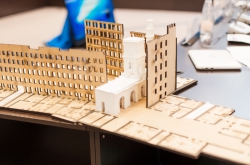Development of lighting design can be an important subject for not only those who chose it as their professional field, but for every person. The reason is quite simple: since the middle of XX century, light has become an effective instrument that can change cityscapes and even one's outlook. Light design offers many opportunities, yet it can also be used against us.
So, what are the things most important for a lighting designer?
First of all, as with any artist, a lighting designer has to understand his or her own self. Persisting in one's opinion is always difficult, especially in this field, where a lot can be decided by the customer's preferences. This is why authors have to take a stand and prove their opinions with research results that substantiate their decisions and their priority over a customer's opinion.
Richard Kelly, one of the pioneers of architectural lighting design, was one of the first people to stress the importance of lighting design theory, its language and what it communicates. When working with renowned architects, he promoted the idea that architecture should "soar". He achieved this effect by working on the buildings' interior: light shone “through”the facade, thus forming a unique texture. Kelly was first to propose to classify light by its purpose: the light that allows us to see, the light that allows us to notice and the light that allows us to look. Kelly explained that light is a powerful instrument that can be used to lay emphasis in architecture and even manipulate people.
Another renowned lighting designer whose individual touch is clearly seen in each of his projects is Roger Narboni. The artist has a very clear position: he only works for cities and people who inhabit them. Roger Narboni promotes the idea that lighting has to serve the city and its people. This is a very important idea, as lighting can also be used to manipulate people. Actually, lighting solutions can be used to distract people's attention from something or, conversely, to motivate them. This is why it is most important for a lighting designer to know how to present his or her ideas to the customers, how to make them think of such issues.
To do that, light designers rely on several research methods. Prototyping allows using light with different types of materials, which results in new forms of light-object interaction. Field observations are also important: when working with architectural forms, it's most important to understand how they will look with and without lighting. Thus, a lighting designer has to constantly analyze such changes.
 Natalya Bystryantseva
Natalya Bystryantseva
"Lighting design's unique feature is that while a natural light source provides for the impression of the building, street or complex as a whole, artificial lighting can be used to emphasize on particular parts," explains Natalya Bystryantseva.
Generative research allows studying what doesn't yet exist in nature. This is the way for a specialist to become familiar with particular forms and see if they will do for his or her idea. Lighting designers even turn to such methods as verbalization, which is usually used by psychologists - an open mind and thirst for new knowledge and solutions are essential qualities that any such specialist has to possess.
"It's most important for lighting designers, as well as any creative professionals, to have integrity and be ready to defend their point of view. At our School, we aspire to train specialists who are ready to do that, as this has to do with deep understanding of the current problems of society, empathy and the like," comments Natalya Bystryantseva.
The problems of humanization, ecology, urbanization and culture are most important topics that people of art have to have an opinion on. When it will be the era of total artificial intelligence, people will yet again focus on understanding themselves. This is why a lighting design specialist's most important task is to focus on the problems the modern society faces.
Why is lighting design something that's essential for everyone?
As we said, light is a powerful instrument that can be used to manipulate the society. That is why understanding the culture of lighting in a city can help resist control over one's emotions. What is more, lighting design has great social, cultural and even philosophical importance.
Science and art have been interacting throughout the world's history. Today, these fields' integration occurs on the background of the rapid development of technology - artists are set on finding new ways to reshape reality, and science provides for the new forms art can take.
 Elena Lekus
Elena Lekus
"The integration that intensifies lighting design's rapid development reflects humanity's search for the fundamentals of a new, holistic outlook - one that will envelop all the new information we've learned,” explains Elena Lekus.
Imagery has the ability to quickly transfer all kinds of information, and through it, we can perceive information at its fullest.
Each culture speaks its own language, and each epoch chooses the most appropriate language for its time - the one that is best at communicating its main ideas. In different times, different forms of art became the dominating ones. Why has lighting design been becoming such a language lately? Why is it so in-demand? We still don't know. Yet, it's already obvious that it offers many new opportunities. As of now, people need new environment that will offer a new type of communication experience. By using lighting design, by combining science and art we can now hope to create it.






